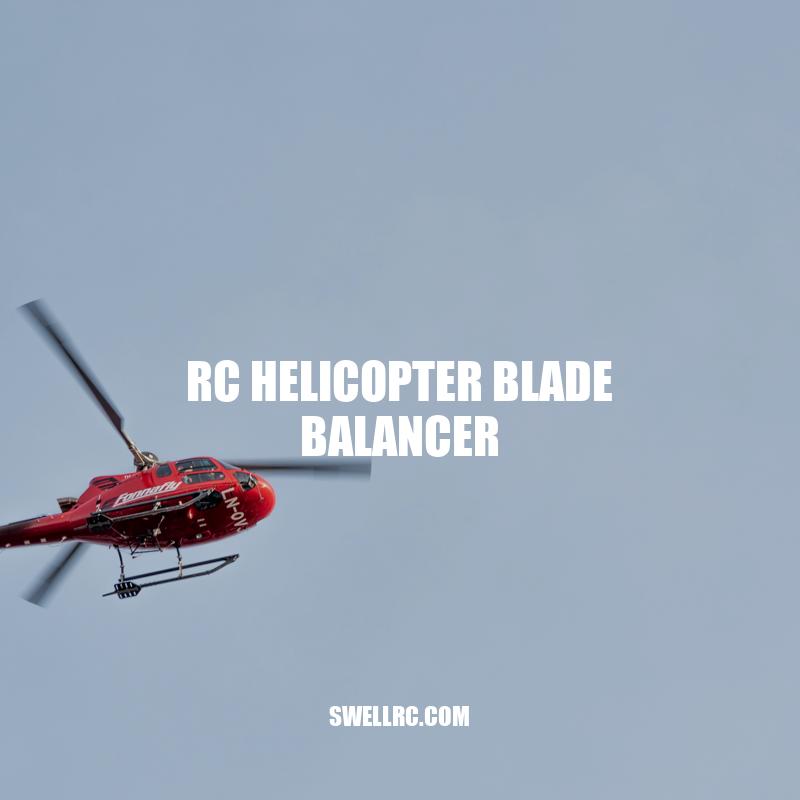Optimizing RC Helicopter Flight Performance with Blade Balancer
When flying RC helicopters, balancing the blades is a crucial aspect that is often overlooked by inexperienced hobbyists. Blade balancing is the process of ensuring that all blades of a helicopter are of equal weight and are installed at the same angle relative to the rotor head. Balancing ensures consistent performance, improves safety and prolongs the helicopter’s lifespan. Imbalanced blades cause vibration, which can lead to excessive wear and tear on the helicopter’s components, reducing its overall lifespan. Even worse, it can result in unpredictable flight behavior and crashes, causing serious injury and damage to property. Therefore, achieving a balanced rotor system is a top priority for any owner of an RC helicopter. In this article, we will explore what an RC helicopter blade balancer is, how to use it, why balancing the blades is essential, the most common mistakes to avoid, and tips for getting the best results.
What Is an RC Helicopter Blade Balancer?
An RC helicopter blade balancer is a tool designed to overcome the imbalances in helicopter blades. It consists of a base and a rotating shaft on which the blades are mounted. The device precisely measures the center of gravity and determines whether the blades are of equal weight and installed at the same angle relative to the rotor head. Blades that are out of balance can cause the helicopter to vibrate excessively, leading to damage as well as a reduction in flight performance. A blade balancer ensures that the blades are balanced and the helicopter runs smoothly without any issues. Most RC helicopter blade balancers come with instructions on their use, but it’s always advisable to research and practice safe procedures before starting.
When shopping for a blade balancer, ensure that you choose a reputable brand from a manufacturer that is known for quality control. Some of the top brands in the RC industry include Align, Thunder Tiger, and Bobbyrc. These brands offer blade balancers with different configurations, functions, and sizes to suit various types of RC helicopters.
To sum up, a RC helicopter blade balancer is an essential tool for any RC helicopter enthusiast. It helps to ensure that your helicopter performs at its best and avoids any damages or accidents due to imbalanced blades. When purchasing a blade balancer, be sure to choose a trusted and reliable brand to ensure quality and performance.
How do you balance a helicopter blade?
Balancing a helicopter blade involves ensuring that the blade’s center of mass coincides with its center of rotation. Here are the steps to balance a helicopter blade:
- Remove any oil, grease, or dirt from the blade surface.
- Place the blade on a horizontal support surface.
- Identify the blade’s center of mass by balancing it on the support surface.
- Mark the location of the center of mass on the blade.
- Attach a balancing fixture to the blade as per the manufacturer’s instructions.
- Suspend the blade and fixture horizontally.
- Determine the amount and location of any necessary balance weight using a balancing machine.
- Add balance weight to the appropriate location of the blade, then test its balance again.
- Repeat the above steps until the blade is calibrated correctly
There are several products available in the market that can help in balancing helicopter blades. One such product is the “HeliBalancer”, which is an electronic device for balancing rotor blades. For more information on helicopter maintenance and repair, you can visit websites like rotorandwing.com or verticalmag.com.
How to Use an RC Helicopter Blade Balancer
Using an RC helicopter blade balancer is easy when following the steps below:
- Ensure the blade balancer is on a flat surface.
- Insert the blades and secure them in place.
- Turn on the blade balancer and allow it to stabilize.
- Check the balance of the blades and adjust them accordingly.
- Repeat the process until the blades are balanced and aligned.
It’s important to note that not all blade balancers are compatible with every type of helicopter blade, so it’s crucial to check beforehand what the specifications are and what the manufacturer recommends. Furthermore, any damage or wear on the blades should also be addressed before balancing, as those issues could be amplified and cause more damage in flight.
To get the most accurate results, consider investing in a digital blade balancer such as the Dubro Tru-Spin Prop Balancer. Not only is it efficient and has better accuracy, but it also makes the process less time-consuming. It comes with a digital display and features a unique pivot design, which allows for quick and easy mounting of most blades.
- It’s important to note what the specifications are and what the manufacturer recommends before balancing.
- Consider investing in a digital blade balancer such as the Dubro Tru-Spin Prop Balancer for more accuracy and efficiency.
- Any damage or wear on the blades should be addressed before balancing.
How are helicopter blades balanced?
Helicopter blades are balanced through a process called tracking, which ensures that all blades are parallel to each other during rotation. This is done by measuring blade height and adjusting the pitch of each blade.
- Tracking is typically done with a specialized tool called a heli-blade tracker.
- Imbalanced blades can cause vibration, which can lead to damage or failure of the aircraft.
For more information on this topic, the website Heliweb Magazine offers articles and resources on helicopter maintenance and procedures.
Balancing the blades of an RC helicopter is crucial for several reasons, including:
- Improved flight performance: Balanced blades reduce vibrations, which provides a smoother, more stable flight experience.
- Longer lifespan: By reducing vibrations, balanced blades reduce the wear and tear on the helicopter’s motor and other components, resulting in a longer lifespan for the aircraft.
- Reduced risk of injury or property damage: Imbalanced blades can cause the helicopter to become unstable in flight, increasing the risk of injury to individuals or damage to property.
In fact, according to the Consumer Product Safety Commission, there have been numerous reports of injuries and property damage caused by RC helicopter accidents. In one instance, an individual reported that an unbalanced main rotor caused their helicopter to “suddenly hop, wobble, and then spin out of control,” resulting in damage to their helicopter and surrounding property.
Given the potential risks associated with imbalanced blades, it’s essential for individuals to invest in an RC helicopter blade balancer and prioritize regular blade maintenance.
| Benefits of balanced blades: |
|---|
| Improved flight performance |
| Longer lifespan of the helicopter’s components |
| Reduced risk of injury or property damage |
- The Consumer Product Safety Commission has reported numerous instances of injuries and property damage caused by RC helicopter accidents.
- Regular blade maintenance and investing in an RC helicopter blade balancer can improve safety and prevent accidents.
What is balancing the main rotor for a helicopter?
Balancing the main rotor for a helicopter involves adjusting the balance of the rotor blades to ensure smooth and stable operation. This is typically done by adjusting the weight of each blade, either through adding or removing small amounts of material or by attaching small weights to the blade. Properly balancing the main rotor helps to reduce vibrations and improve the helicopter’s performance. For more information on helicopter maintenance and repair, check out websites such as VerticalReference.com or HelicopterMaintenanceMagazine.com.
Common Mistakes to Avoid When Balancing RC Helicopter Blades
Even with the help of an RC helicopter blade balancer, there are still common mistakes that individuals make when balancing their helicopter blades. Some of these include:
- Not properly cleaning the blades: Dirt or debris on the blades can add weight and throw off the balancing process. It’s important to thoroughly clean the blades before attempting to balance them.
- Not tightening the balance screws: If the balance screws aren’t tightened properly, the blades can shift during flight, causing re-imbalances and vibrations.
- Failing to calibrate the blade balancer: Before using an RC helicopter blade balancer, it’s important to calibrate the device and ensure that it’s reading accurately.
- Ignoring individual blade weight differences: Each blade may have a slightly different weight, which can affect the balance. It’s important to account for these differences when balancing the blades.
By avoiding these common mistakes and taking careful steps to balance the blades, individuals can achieve the best results and improve the performance and safety of their RC helicopter.
In addition to investing in a blade balancer, there are other tools and resources available that can help individuals maintain their RC helicopter and prevent accidents. For example, there are online forums where individuals can connect with other RC helicopter enthusiasts and share tips and advice on maintenance and repair. There are also websites that offer replacement parts and tools tailored specifically to RC helicopter maintenance and repair.
How do you balance RC helicopter blades?
Balancing RC helicopter blades is important for stability and performance. Here are the steps to follow:
1. Remove the blades from the helicopter.
2. Place each blade on a blade balancer.
– You can use a commercial blade balancer like this one from Dubro or build your own using a rod and some bearings.
3. Check the balance of each blade.
– The blade should be perfectly horizontal on the balancer.
– If one end of the blade is heavier than the other, it will tilt towards the heavier end.
– Mark the heavier end of the blade with a piece of tape or a marker.
4. Add weight to the lighter end of the blade.
– You can use small pieces of tape, sandpaper or even glue to add weight.
– Keep adding weight until both ends of the blade are balanced.
5. Repeat the process for the other blade.
Once both blades are balanced, reattach them to the helicopter and test the flight. You should see a significant improvement in stability and performance.
For more detailed instructions and tips, check out RC Helicopter Guide’s article on balancing helicopter blades. They also offer a variety of blade balancers and tools to help with the process.
Conclusion
Balancing RC helicopter blades is an important step in maintaining optimal flight performance and safety. By investing in an RC helicopter blade balancer and avoiding common mistakes during the balancing process, individuals can improve the stability and control of their helicopter. Taking the time to balance the blades properly can also help prevent accidents and prolong the life of the helicopter.
While investing in a blade balancer is an important step, there are also other resources available for maintaining and repairing RC helicopters. Online forums and communities can provide valuable advice and support from other enthusiasts, while websites offering replacement parts and tools can minimize downtime and reduce the need for expensive repairs.
In summary, balancing RC helicopter blades is a straightforward but important process that can improve the performance and safety of an RC helicopter. By following proper techniques and investing in the right tools, individuals can enjoy this exciting hobby without risking unnecessary accidents or damage to their equipment.



